The results are surprising, Quality Score and Cost Per Click are more clearly correlated when you look at Exact Match keywords.
close
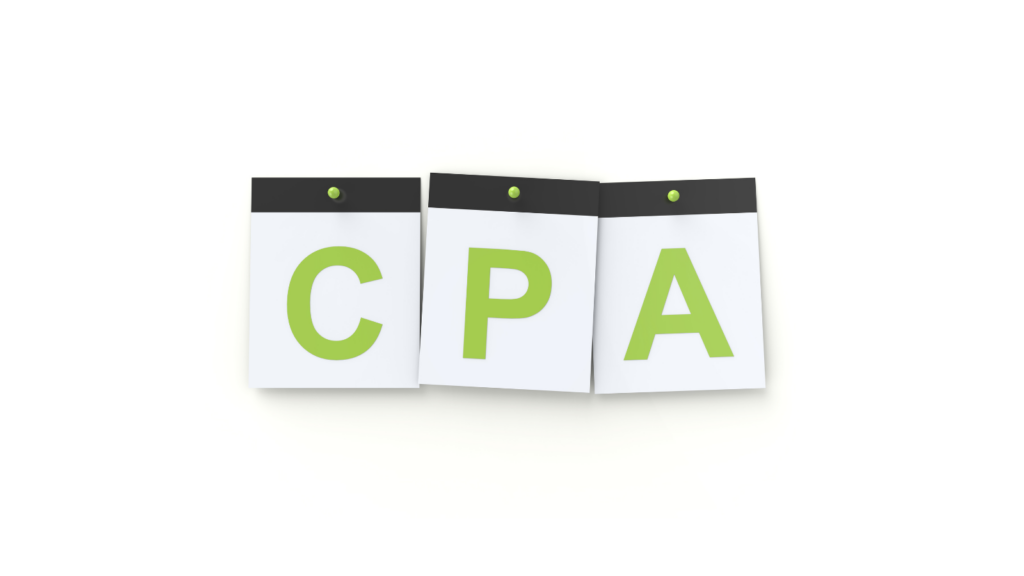
You learn something from years of working on Google Ads accounts. What works, what doesn't work.
What I'm about to go over consistently works on any account, even those performing within their KPIs.
We had just started running an Adwords account for Springer Nature Author Services. Springer Nature is a global conglomerate that publishes the world-renowned academic journal Nature Communications.
The account was performing well, the CPA was within the target range, and there were no immediate issues on the surface. You might think that with an account meeting its goals, there would be no room for improvement.
However, by restructuring the account and moving away from automated campaigns, we reduced the cost per conversion by 59% while increasing conversion value by 39%.
We looked at the last ten years of advertisements, keywords, and search terms to determine which keywords were converting and which ones weren't.
We were surprised to find that most of the sales in this account resulted from specific long-tail search terms, even though most of the campaigns targeted broad-match keywords.
The automated bid strategy was aimed at finding new customers with keywords like "paper proofreading," but the sales came from search terms like "Nature editing." (Pictured below)

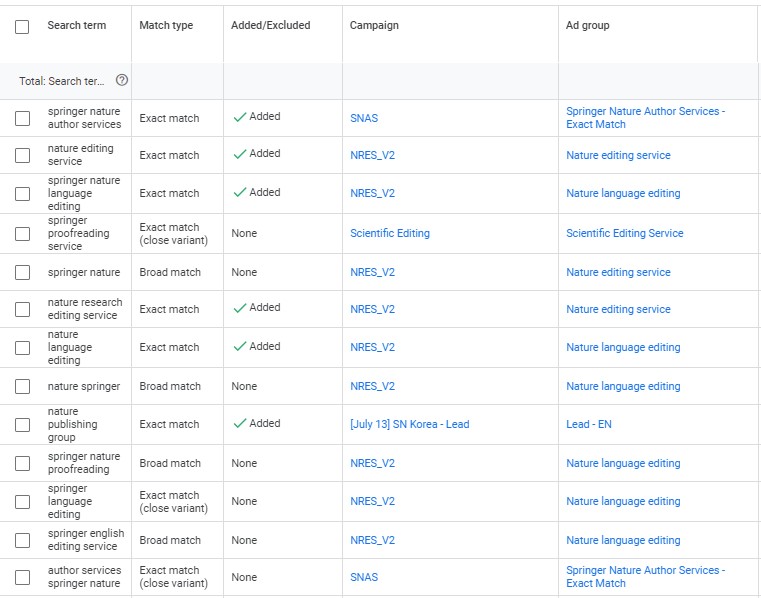
Problem: Branded keywords are known to us; there are practically no reasons you'd want to use an automated bid strategy for a long tail keyword that results in sales.
Keywords should be thought of as categories. Keywords represent concepts and intents; in Google's eyes, "paper editing " is a synonym for "Springer Nature Author Services."
In this case, the keywords about "paper editing" are all synonyms for a site that provides paper proofreading services.
Auctions are more complex than they used to be. Ad Rank is the formula that determines how much you end up paying for a click.
In 2016, Ad Rank was simple: Max CPC x Quality Score = Ad Rank.
In 2022, Ad Rank is based on a mixture of bid, quality score, ad quality, topic, position, signal, and related auctions.
Both manual and smart campaigns can bid based on many different signals. The real issue with automated campaigns is that you can't easily control how much they decide to bid for random signals.
For example, an AI might want to put you in the top spot of search results which can add +300% to your auction. The AI will continue to bid on other signals like the user's favorite type of music, which adds another +162% to the bid.
You can see how your original costs can skyrocket. By contrast, for some keywords, time of day, location, or other bid signals might help improve performance. The signals also might be completely meaningless.
Where AI shines: AI does a great job of bidding on short-tail keywords. I ran a PPC budget in 9 languages, and we had a very cost-effective keyword that was also an acronym, like "ACME." The problem was that the same letters meant something entirely different in different languages. This is where AI shines. It can navigate through bidding on short-tail keywords with various meanings.
Google released a survey in which 95% of advertisers used tCPA smart bidding. The reasons one might run AI-powered campaigns might be for data collection or keyword coverage.
In some ways, automated bidding works better than old-fashioned PPC marketing. The old-fashioned way involves putting together a laundry list of keywords and monitoring the performance, which requires work from your agency.
Google's AI can take the work out of marketing, but it has some limits.
"After a necessary learning period, your campaign should begin to optimize either within two weeks or after it generates about 50 conversions, whichever comes first."
Source: Google
"Begin to optimize" is a generous description by Google of what can happen if your AI campaigns don't have the necessary 50 conversions in 30 days—considering that 75% of small businesses don't even install conversion tracking.
From what I can tell, AI-powered campaigns collect data by bidding on random phrases loosely connected to the keywords in the campaign. Then they optimize towards the signals that result in that conversion goal.
The campaigns randomly guess for infinity by design, regardless of whether or not they achieve the minimum conversion number. If 16%-20% of daily search terms are brand new, the benefit of an AI campaign is that it can cover every new keyword variant. That also comes with the costs associated with randomly bidding on 100% irrelevant phrases.
My suggestion is to use a combination of manual and automated campaigns together. The random guesswork conducted by automated campaigns will ensure you have keyword coverage, and you may even discover new keywords to add to your manual CPC campaigns. At the same time, manual CPC campaigns will keep your costs under control.
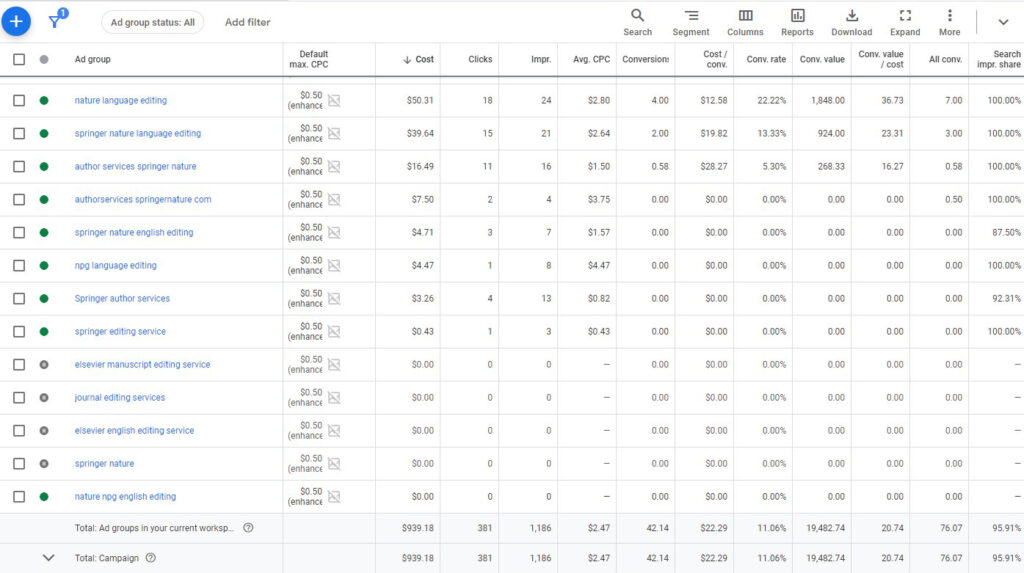
We took the high-performing search terms from the keyword report above, then created Adgroups for each search term. Most of these terms were long-tail keywords.
Using the data we collected about which keywords were performing, we restructured the ad groups into single-keyword ad groups or SKAGs. The benefit of SKAGs is that they enable us to create hyper-targeted ads that match the advertised keyword. This, in theory, raises the quality score and Ad Rank, reducing costs.
Months later, we saw some significant savings in costs from this change. Remember, all we did was restructure the campaigns.
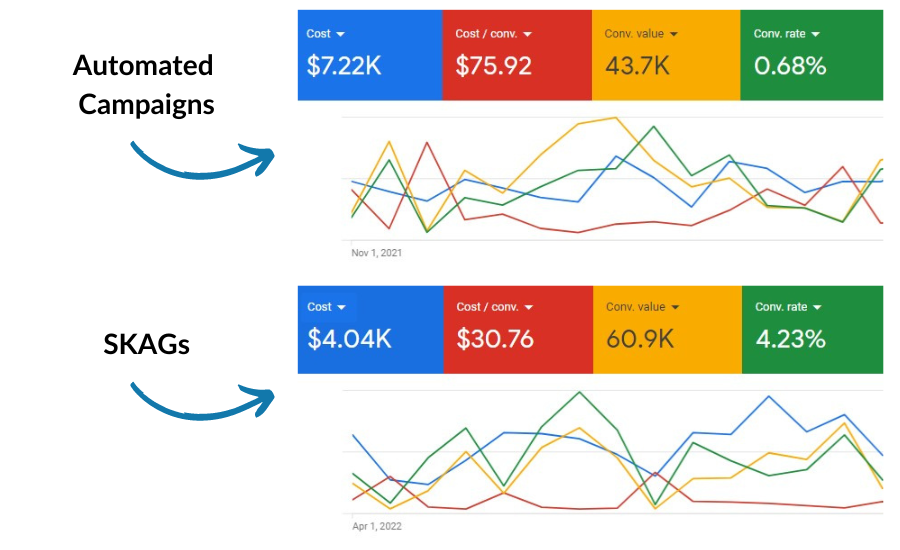
For good measure, we did not completely disable the automated campaigns. One added benefit of creating a SKAG is that since its quality score is higher, the SKAG will generally take priority over the automated campaigns for whatever keywords you put into your SKAG. In a way, you're forcing the automated campaign to do what they're supposed to do, bid for keyword coverage.
Your account will only show one ad for one keyword per domain at any given time. You can have 30 accounts advertising the same domain, but only one ad will show.
Which ad will show is determined by the quality of the advertisement. Recall that SKAGs generally have higher quality scores and Ad Ranks than their automated counterparts because you can use targeted ad text and landing pages on a per-keyword basis.
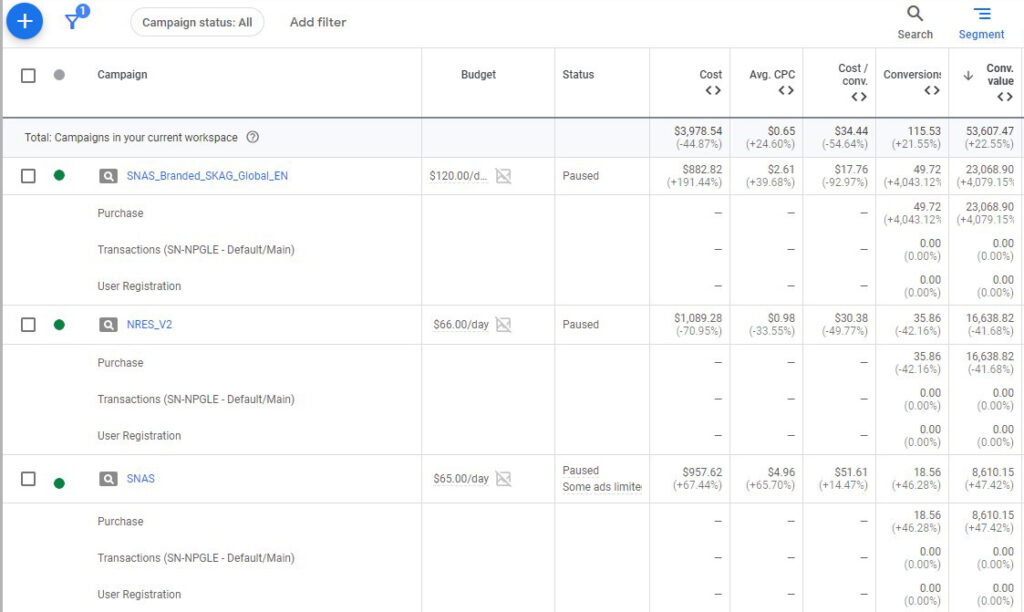
The picture above shows that the campaign labeled "SKAG" is automatically eating up the high-converting keywords at a lower cost. As a result, it's forcing the automated campaign costs to go down as well - because the automated campaigns were bidding up prices for the same keyword using signals that didn't make any sense. The main automated campaign in this account was spending 70% less than it was a few months ago.
We now have campaigns that have higher quality scores and more predictable clicks.
Keeping the automated campaign running enables us to maintain keyword coverage and growth. It's the best of both worlds.
By summertime, costs averaged 59% less, while conversion value was up 39%.

The results are surprising, Quality Score and Cost Per Click are more clearly correlated when you look at Exact Match keywords.
I love WordPress for its customizations. Styling code snippets enhances user perceptions. Copy and paste the code below to style your WordPress code blocks.
The code snippet plugin changed my life. I no longer edit the raw PHP files to add simple functions like titles to users' profiles.
By restructuring your account and using hyper-targeted ad text, CPA can be reduced.
YMYL stands for "Your Money or Your Life." Google uses YMYL to help understand if a web page's main content could impact people's safety, health, or financial well-being.
With slight modifications to Optinmonster's native A/B testing capabilities, it becomes an excellent CRO testing tool.

The results are surprising, Quality Score and Cost Per Click are more clearly correlated when you look at Exact Match keywords.
I love WordPress for its customizations. Styling code snippets enhances user perceptions. Copy and paste the code below to style your WordPress code blocks.
The code snippet plugin changed my life. I no longer edit the raw PHP files to add simple functions like titles to users' profiles.
By restructuring your account and using hyper-targeted ad text, CPA can be reduced.
YMYL stands for "Your Money or Your Life." Google uses YMYL to help understand if a web page's main content could impact people's safety, health, or financial well-being.
With slight modifications to Optinmonster's native A/B testing capabilities, it becomes an excellent CRO testing tool.
